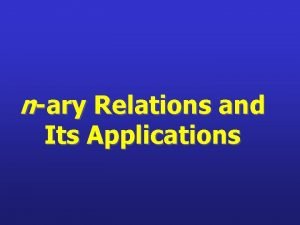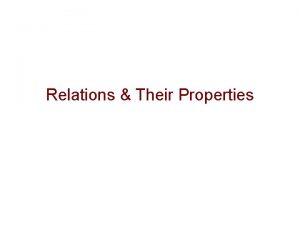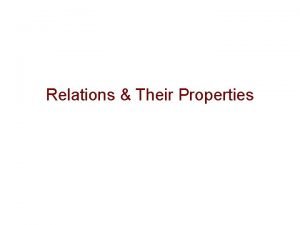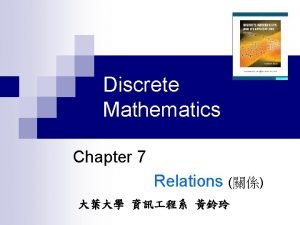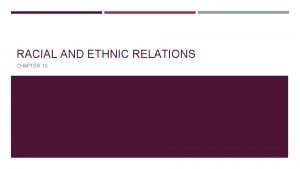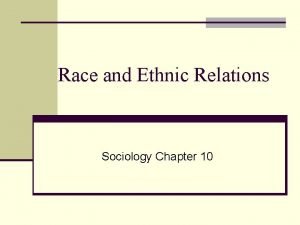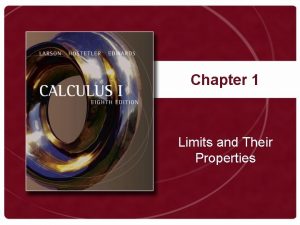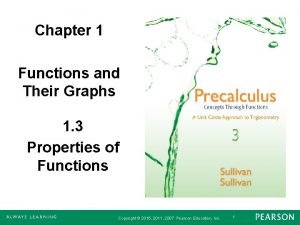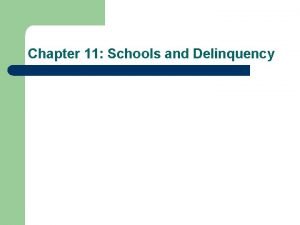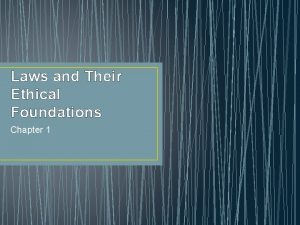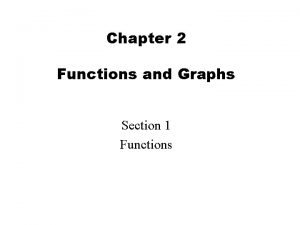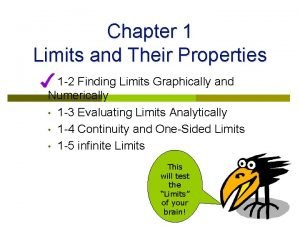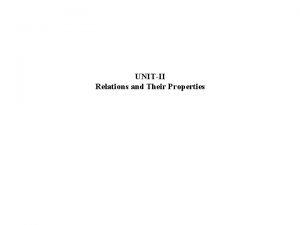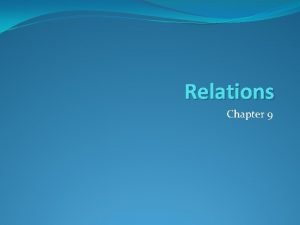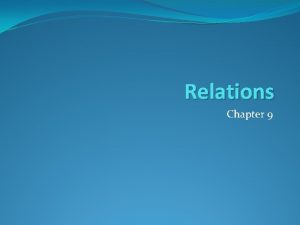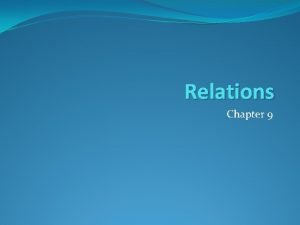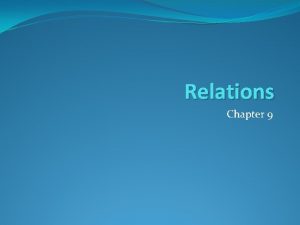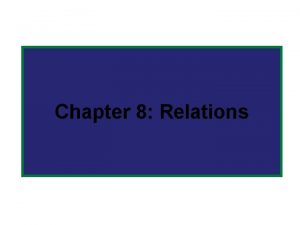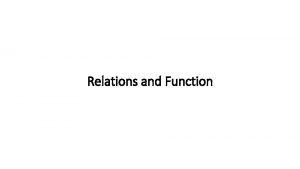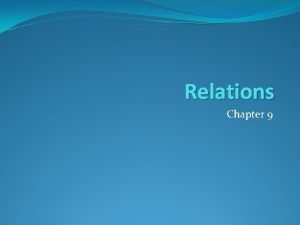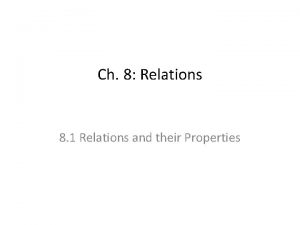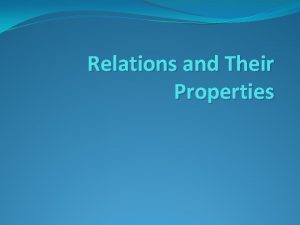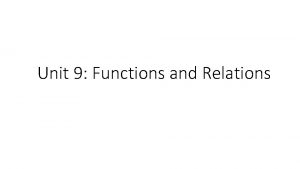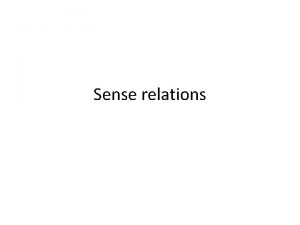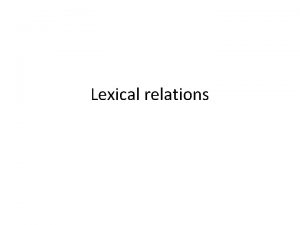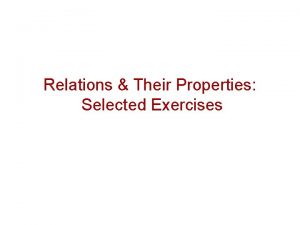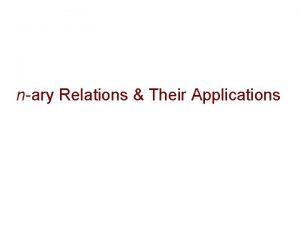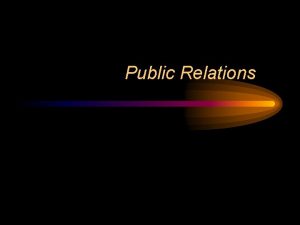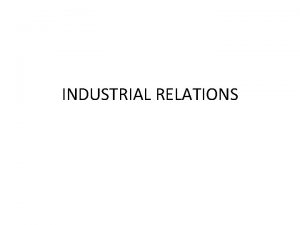Chapter 8 Relations 8 1 Relations and their























- Slides: 23

Chapter 8: Relations

8. 1 Relations and their properties Binary relation • Let A, B be any two sets. • A binary relation R from A to B, written R: A↔B, is a subset of A×B. • The notation a R b or a. Rb means (a, b) R. • If a. Rb we may say “a is related to b (by relation R)”, or “a relates to b (under relation R)”.

Example Let R: A B A = {1, 2, 3} represents students B = {a, b} represents courses A×B= { (1, a), (1, b), (2, a), (2, b), (3, a), (3, b)} R = { (1, a), (1, b) } it means that student 1 registered in courses a and b

Relations can be represented by: A. Roaster Notation: List of ordered pairs Ex: Let A be the set {1, 2, 3, 4}, which ordered pairs are in the relation R={(a, b)| a divides b}? R= {(1, 1), (2, 2), (3, 3), (4, 4), (1, 3), (1, 2), (1, 4), (2, 4)} B. Set builder notation Ex: R={(a, b)| a divides b}

C. Graph R 1 = {(1, 1), (2, 2), (3, 3), (4, 4), (1, 3), (1, 2), (1, 4), (2, 4)} 1 1 2 2 3 3 4 4 OR 1 2 3 4


Relations on a Set • A (binary) relation from a set A to itself is called a relation on the set A. Example: The “<” relation defined as a relation on the set N of natural numbers. let < : N↔N : ≡ {(a, b) | a < b} If (a, b) R then a < b means (a, b) < ex: (1, 2) <

• The identity relation IA on a set A is the set {(a, a)|a A}. Example: A = {1, 2, 3, 4} IA = {(1, 1), (2, 2), (3, 3), (4, 4)}

Example: R 1= {(a, b)| a ≤ b} R 2= {(a, b)| a =b or a=-b} R 3= {(a, b)| a+b ≤ 3} Which of these relations contain each of the following pairs (1, 1), (1, 2), (1, -1)? (1, 1) is in R 1, R 2, R 3 (1, 2) is in R 1, R 2 (1, -1) is in R 2, R 3

Question • How many relations are there on a set with n elements? 1. A relation on set A is a subset from A x A. 2. A has n elements so A x A has n 2 elements. 3. Number of subsets for n 2 elements is Thus there are elements relations on a set with n

Example • S ={a, b, c} There are : relations

Properties of Relations 1. Reflexivity & Irreflexivity A relation R on A is reflexive if (a, a) R for every element a A. Ex: Consider the following relations on {1, 2, 3, 4} 1. R 1={(1, 1), (1, 2), (2, 1), (2, 2), (3, 4), (4, 1), (4, 4} Not Reflexive 2. R 2={(1, 1), (2, 2), (3, 3), (3, 4), (4, 4)} Reflexive 3. R 3 = {(a, b) | a ≤ b} Reflexive

A relation R on A is irreflexive if for every element a A, (a, a) R Note: “irreflexive” ≠ “not reflexive” Example: A= {1, 2} R = {(1, 2), (2, 1), (1, 1)} Not Reflexive because (2, 2) R Not irrflexive because (1, 1) R

Example: 1 2 3 4 Not Reflexive and Not Irreflexive

• Examples: 1 2 3 4 Irreflexive 1 2 3 4 Reflexive

2. Symmetry & Antisymmetry • A binary relation R on A is symmetric if (a, b) R ↔ (b, a) R. where a, b A • A binary relation R on A is antisymmetric if (a, b) R → (b, a) R. also: (a, b) R (b, a) R →(a=b)

Example Let A = {1, 2, 3} R 1={(1, 2), (2, 2), (3, 1), (1, 3)} Not reflexive, not irreflexive, not symmetric, not antisymmetric R 2={(2, 2), (1, 3), (3, 2)} Not reflexive, not irreflexive, Not symmetric, Antisymmetric R 3 = {(1, 1), (2, 2), (3, 3)} reflexive, not irreflexive, symmetric, antisymmetric R 4= {(2, 3)} not reflexive, irreflexive, Not Symmetric, antisymmetric

Example Consider these relations on the set of integers: R 1={(a, b) | a=b} symmetric , antisymmetric R 2={(a, b) | a>b} not symmetric, antisymmetric R 3={(a, b) | a=b+1} not symmetric, antisymmetric

3. Transitivity • A relation R is transitive iff (for all a, b, c) (a, b) R (b, c) R → (a, c) R. Examples: A= {1, 2} R 1={(1, 1), (1, 2), (2, 1), (2, 2)} transitive R 2={(1, 1), (1, 2), (2, 1)} not transitive, (2, 2) R 2 R 3 ={(3, 4)} transitive

Special cases Empty set {} irreflexive, transitive, symmetric, antisymmetric U universal set. Reflexive, transitive, symmetric

Combining Relations Let A={1, 2, 3} , B={1, 2, 3, 4} R 1={(1, 1), (2, 2), (3, 3)} R 2={(1, 1), (1, 2), (1, 3), (1, 4)} R 1 R 2 = {(1, 1), (2, 2), (3, 3), (1, 2), (1, 3), (1, 4)} R 1 R 2= {(1, 1)} R 1 - R 2={(2, 2), (3, 3)}

Composite Relations • If (a, c) is in R 1 and (c, b) is in R 2 then (a, b) is in R 2◦ R 1 Ex: R is the relation from {1, 2, 3} to {1, 2, 3, 4} R={(1, 1), (1, 4), (2, 3), (3, 1), (3, 4)} S is the relation from {1, 2, 3, 4} to {0, 1, 2} S = {{1, 0), (2, 0), (3, 1), (3, 2), (4, 1)} • S◦R = {(1, 0), (1, 1), (2, 2), (3, 0), (3, 1)}

Power • Let R be a relation on the set A. the power Rn, n=1, 2, 3… are defined by R 1 =R and Rn = Rn-1 ◦ R Ex: Let R ={(1, 1), (2, 1), (3, 2), (4, 3)}. Find: • R 2 = {(1, 1), (2, 1), (3, 1), (4, 2)} • R 3 = R 2 ◦ R= {(1, 1), (2, 1), (3, 1), (4, 1)}
 N-ary relations
N-ary relations Relations and their properties
Relations and their properties Relations and their properties
Relations and their properties Relations and their properties
Relations and their properties Employee relations in public relations
Employee relations in public relations Romeo + juliet prologue
Romeo + juliet prologue Chapter 10 racial and ethnic relations review worksheet
Chapter 10 racial and ethnic relations review worksheet Chapter 10 racial and ethnic relations
Chapter 10 racial and ethnic relations Chapter 10 racial and ethnic relations review worksheet
Chapter 10 racial and ethnic relations review worksheet Chapter 26 section 1 arthropod characteristics answer key
Chapter 26 section 1 arthropod characteristics answer key Principles of ecology section 3 cycling of matter
Principles of ecology section 3 cycling of matter Principles of ecology chapter 2 section 1 answer key
Principles of ecology chapter 2 section 1 answer key Chapter 2 section 1 organisms and their relationships
Chapter 2 section 1 organisms and their relationships Chapter 2 principles of ecology answers
Chapter 2 principles of ecology answers Chapter 18 genomes and their evolution
Chapter 18 genomes and their evolution Carbon family
Carbon family Chapter 1 limits and their properties
Chapter 1 limits and their properties Chapter 1 functions and their graphs
Chapter 1 functions and their graphs Chapter 11 school policies and their functions
Chapter 11 school policies and their functions Chapter 1 laws and their ethical foundation
Chapter 1 laws and their ethical foundation Chapter 2 functions and their graphs answers
Chapter 2 functions and their graphs answers Chapter 1 limits and their properties
Chapter 1 limits and their properties Special trig limits
Special trig limits Chapter 17 overview elements and their properties
Chapter 17 overview elements and their properties
